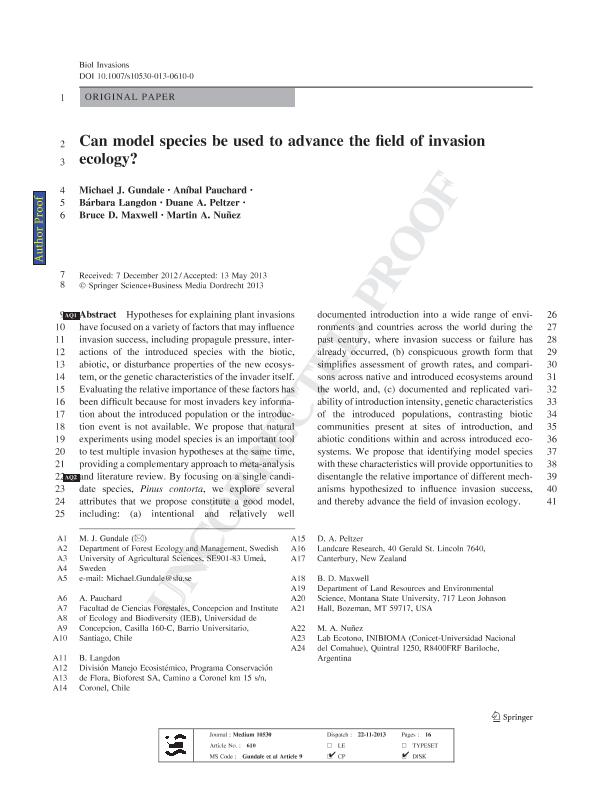Artículo
Can model species be used to advance the field of invasion ecology?
Gundale, Michael; Pauchard, Aníbal; Langdon, Bárbara; Peltzer, Duane A.; Maxwell, Bruce D.; Nuñez, Martin Andres

Fecha de publicación:
01/2014
Editorial:
Springer
Revista:
Biological Invasions
ISSN:
1387-3547
Idioma:
Inglés
Tipo de recurso:
Artículo publicado
Clasificación temática:
Resumen
Hypotheses for explaining plant invasions have focused on a variety of factors that may influence invasion success, including propagule pressure, interactions of the introduced species with the biotic, abiotic, or disturbance properties of the new ecosystem, or the genetic characteristics of the invader itself. Evaluating the relative importance of these factors has been difficult because for most invaders key information about the introduced population or the introduction event is not available. We propose that natural experiments using model species is an important tool to test multiple invasion hypotheses at the same time, providing a complementary approach to meta-analysis and literature review. By focusing on a single candidate species, Pinus contorta, we explore several attributes that we propose constitute a good model, including: (a) intentional and relatively well documented introduction into a wide range of environments and countries across the world during the past century, where invasion success or failure has already occurred, (b) conspicuous growth form that simplifies assessment of growth rates, and comparisons across native and introduced ecosystems around the world, and, (c) documented and replicated variability of introduction intensity, genetic characteristics of the introduced populations, contrasting biotic communities present at sites of introduction, and abiotic conditions within and across introduced ecosystems. We propose that identifying model species with these characteristics will provide opportunities to disentangle the relative importance of different mechanisms hypothesized to influence invasion success, and thereby advance the field of invasion ecology.
Palabras clave:
N/A
Archivos asociados
Licencia
Identificadores
Colecciones
Articulos(INIBIOMA)
Articulos de INST. DE INVEST.EN BIODIVERSIDAD Y MEDIOAMBIENTE
Articulos de INST. DE INVEST.EN BIODIVERSIDAD Y MEDIOAMBIENTE
Citación
Gundale, Michael; Pauchard, Aníbal; Langdon, Bárbara; Peltzer, Duane A.; Maxwell, Bruce D.; et al.; Can model species be used to advance the field of invasion ecology?; Springer; Biological Invasions; 16; 3; 1-2014; 591-607
Compartir
Altmétricas



